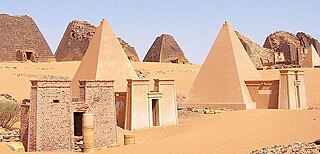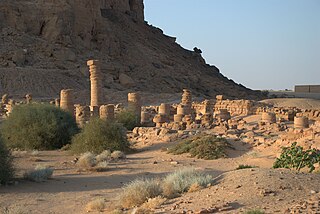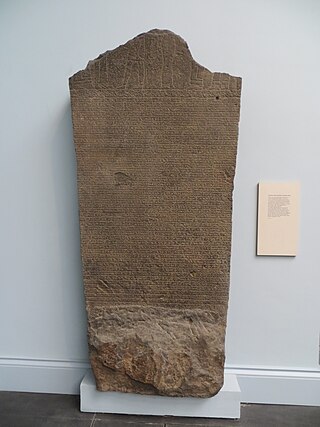
Meroë was an ancient city on the east bank of the Nile about 6 km north-east of the Kabushiya station near Shendi, Sudan, approximately 200 km north-east of Khartoum. Near the site is a group of villages called Bagrawiyah. This city was the capital of the Kingdom of Kush for several centuries from around 590 BC, until its collapse in the 4th century AD. The Kushitic Kingdom of Meroë gave its name to the "Island of Meroë", which was the modern region of Butana, a region bounded by the Nile, the Atbarah and the Blue Nile.

Jebel Barkal or Gebel Barkal is a mesa or large rock outcrop located 400 km north of Khartoum, next to Karima in Northern State in Sudan, on the Nile River, in the region that is sometimes called Nubia. The jebel is 104 m tall, has a flat top, and came to have religious significance for both ancient Kush and ancient Egyptian occupiers. In 2003, the mountain, together with the extensive archaeological site at its base, were named as the center of a World Heritage Site by UNESCO. The Jebel Barkal area houses the Jebel Barkal Museum.
Napata was a city of ancient Kush at the fourth cataract of the Nile founded by the Egyptian Amun cult for Egyptian pilgrims given by its, as suggested, Egyptian name. It is located approximately 1.5 kilometers from the east side of the river at the site of modern Karima, Sudan. It was the southernmost permanent settlement in the New Kingdom of Egypt and home to Jebel Barkal, the main Kushite cult centre of Amun. It was the sometime capital of the Twenty-fifth Dynasty of Egypt and, after its fall in 663 BC, of the Kingdom of Kush. In 593 BC, it was sacked by the Egyptians and the Kushite capital was relocated to Meroë. Even after this move, Napata continued to be the kingdom's primary religious centre. The city was sacked a second time by the Romans in 23 BC but was rebuilt and continued as an important centre of the Amun cult.

Natakamani, also called Aqrakamani, was a king of Kush who reigned from Meroë in the middle of the 1st century CE. He ruled as co-regent together with his mother Amanitore. Natakamani is the best attested ruler of the Meroitic period. He and Amanitore may have been contemporaries of the Roman emperor Nero.

Amanishakheto was a queen regnant (kandake) of Kush who reigned in the early 1st century AD. In Meroitic hieroglyphs her name is written "Amanikasheto". In Meroitic cursive she is referred to as Amaniskheto qor kd(ke) which means Amanishakheto, Qore and Kandake.

Gaius Petronius or Publius Petronius was the second and then fourth Prefect of Roman Aegyptus.

Kandake, kadake or kentake, often Latinised as Candace, was the Meroitic term for the sister of the king of Kush who, due to the matrilineal succession, would bear the next heir, making her a queen mother. She had her own court, probably acted as a landholder and held a prominent secular role as regent. Contemporary Greek and Roman sources treated it, incorrectly, as a name. The name Candace is derived from the way the word is used in the New Testament.

Amanitore, also spelled Amanitere or Amanitare, was a queen regnant of the Kingdom of Kush, ruling from Meroë in the middle of the 1st century CE. She ruled together with her son, Natakamani. The co-reign of Amanitore and Natakamani is a very well attested period and appears to have been a prosperous time. They may have been contemporaries of the Roman emperor Nero.

Nubia is a region along the Nile river encompassing the area between the first cataract of the Nile and the confluence of the Blue and White Niles, or more strictly, Al Dabbah. It was the seat of one of the earliest civilizations of ancient Africa, the Kerma culture, which lasted from around 2500 BC until its conquest by the New Kingdom of Egypt under Pharaoh Thutmose I around 1500 BC, whose heirs ruled most of Nubia for the next 400 years. Nubia was home to several empires, most prominently the Kingdom of Kush, which conquered Egypt in the eighth century BC during the reign of Piye and ruled the country as its 25th Dynasty.

The Kingdom of Kush, also known as the Kushite Empire, or simply Kush, was an ancient kingdom in Nubia, centered along the Nile Valley in what is now northern Sudan and southern Egypt.
The geographical region of ancient Nubia covers the area from the First Cataract at Aswan in the north, to the Blue and White Niles at Khartoum in the south, and adjacent deserts. The region includes the Nile Valley of lower Egypt and nowadays Sudan. The earliest history of Nubia dates to the Paleolithic period, and the civilization of ancient Nubia developed alongside ancient Egypt on the Nile valley. Both Egypt and Nubia are characterized by their distinct cultural identities and had lots of interactions—military, political, and commercial—throughout history. Prior to Roman contact, Kush had trade relations with Ptolemaic Egypt. The early interaction between Rome and the kingdom of Kush in Nubia was full of tensions and conflicts before Caesar Augustus established a peace treaty with Kush. Nubia thereby flourished for nearly three centuries through trade with Roman Egypt. Archaeological excavations and written accounts by Classical authors such as Strabo, Pliny the Elder, and Diodorus are important sources of information about Roman relations with Nubia.

The Temple of Amun is an archaeological site at Jebel Barkal in Northern State, Sudan. It is situated about 400 kilometres (250 mi) north of Khartoum near Karima. The temple stands near a large bend of the Nile River, in the region that was called Nubia in ancient times. The Temple of Amun, one of the largest temples at Jebel Barkal, is considered sacred to the local population. Not only was the Amun temple a main centre of what at one time was considered to be an almost universal religion, but, along with the other archaeological sites at Jebel Barkal, it was representative of the revival of Egyptian religious values. Up to the middle of the 19th century, the temple was subjected to vandalism, destruction, and indiscriminate plundering, before it came under state protection.

The Hamadab Stela is a colossal sandstone stela found at Hamadab just south of the ancient site of Meroë in Sudan. Now kept at the British Museum, the significance of the stela resides in the fact that it is inscribed with one of the longest known texts in the Meroitic script.

The Meroë Head, or Head of Augustus from Meroë, is a larger-than-life-size bronze head depicting the first Roman emperor, Augustus, that was found in the ancient Nubian site of Meroë in modern Sudan in 1910. Long admired for its striking appearance and perfect proportions, it is now part of the British Museum's collection. It was looted from Roman Egypt in 24 BC by the forces of queen Amanirenas of Kush and brought back to Meroë, where it was buried beneath the staircase of a temple.

The Triakontaschoinos, Latinized as Triacontaschoenus, was a geographical and administrative term used in the Greco-Roman world for the part of Lower Nubia between the First and Second Cataracts of the Nile, which formed a buffer zone between Egypt and later Rome on the one hand and Meroë on the other hand. The northern part of this area, stretching from the First Cataract south to Maharraqa, was known as the Dodekaschoinos or Dodecaschoenus. In the Ptolemaic and Roman periods the Dodekaschoinos was often annexed to Egypt or controlled from it, and the rest of the Triakontaschoinos sometimes was as well.

Nawidemak was a queen regnant of Kush who probably ruled in the first half of the 1st century AD. She is known from the wall relief of her burial chamber, as well as a gold plaque.
Maloqorebar was an ancient Kushite prince.

Nubia is a region along the Nile river encompassing the area between the first cataract of the Nile as well as the confluence of the blue and white Niles or, more strictly, Al Dabbah. Nubia was the seat of several civilizations of ancient Africa, including the Kerma culture, the kingdom of Kush, Nobatia, Makuria and Alodia.
Talakhidamani was the king of Kush in the mid or late 3rd century AD, perhaps into the 4th century. He is known from two Meroitic inscriptions, one of which commemorates a diplomatic mission he sent to the Roman Empire.

Kushite religion is the traditional belief system and pantheon of deities associated with the Ancient kushites, who founded the Kingdom of Kush in the land of Kush in present-day Sudan.



















